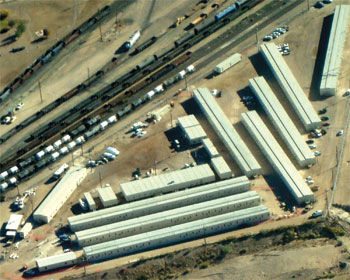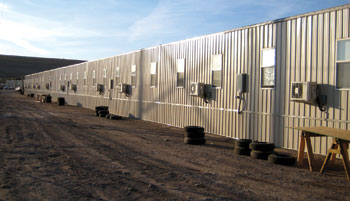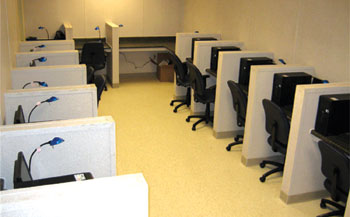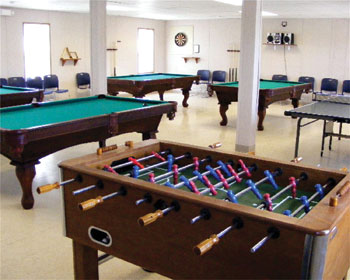By Richard Rothaus
Well-organized workforce housing can be a valuable partner for companies pursuing their sustainable development goals, as well as a component of long-term profitability
 The Desert Sage Lodge is a 425-bedroom workforce complex that provides on-site housing for miners in Morenci, Arizona, USA. (Photos courtesy of Target Logistics)
The Desert Sage Lodge is a 425-bedroom workforce complex that provides on-site housing for miners in Morenci, Arizona, USA. (Photos courtesy of Target Logistics)
Structured workforce housing presents a valuable opportunity for companies to meet operational goals of sustainable development. Sustainable development has been recognized as necessary for medium- and large-sized companies to remain competitive in a global marketplace.
Successful businesses must be both “eco-efficient” (with the economic value-added being proportional to environmental impact) and “socio-efficient” (with the economic value-added being proportional to social impact). In other words, long-term business success requires attention to not only short- and long-term economic capital, but also long-term natural and social capital.
Companies that ignore this reality run the risk of issues in supply chains, workforce availability and access to areas with desirable natural resources. Sustainable development is not an abstract principle, but a real component of 21st century business success.
Such housing has its origins in the Texas oil booms of the 1930s and 40s, when oil companies attempted to address the untenable situations of workers living in squalor and small towns overrun and paralyzed by sudden population booms.
Well-organized workforce housing is an area where businesses easily can address some of their sustainable development goals. Such accommodations serve to protect the health and safety of workers, as well as the health and safety of the communities where companies do business. At the heart of long-term health and safety is sustainable development, as it helps guarantee clean air, water, land and communities for future generations.
Three Pillars of Sustainable Development
Well-organized workforce housing solutions address the three pillars of sustainable development: social, environmental and economic. For businesses, these translate into the “triple bottom line” of 1) social responsibility, 2) natural capital and 3) economic prosperity, as well as the recognition that none of these can easily substitute for another.
Social Responsibility
Good relationships with these communities are essential for continued operations in such areas, and quality workforce housing offers solutions to real problems. An influx of workers plays havoc with housing availability and pricing, often creating hardships for locals who can be squeezed out of the market. While this effect is perhaps inevitable in any boom economy, companies that utilize workforce housing keep the majority of their employees out of the housing market, reducing the negative aspects of housing economics.
Workforce housing that’s professionally managed also can address major and very real infrastructure concerns. Workers, for example, do not overwhelm the existing water and sewage systems, because the housing provides its own. Further, local retailers aren’t overwhelmed, causing periodic shortages and long waits for goods and services.
One of the biggest, and largely unnoticed, impacts of such accommodations is reduced road traffic. Like water and sewage, road infrastructure is expensive and slow to catch up with a boom environment.
While the majority of the wear and tear comes from truck traffic, the thousands of workers also have a major impact, especially on traffic congestion, dust control issues and emissions.
 These modular units at Desert Sage are not fazed by the brutal desert heat, as they are built to withstand the most extreme conditions.
These modular units at Desert Sage are not fazed by the brutal desert heat, as they are built to withstand the most extreme conditions.
By getting thousands of workers out of private vehicles and onto buses and into van pools, workforce housing can be a strong contributor to reducing impacts on local transportation infrastructure. With reduced traffic and centralized living, quality workforce housing also directly addresses the safety and security concerns of employers, employees and locals. Companies that place their people in such accommodations effectively keep their employees in a secure and monitored environment nearly 24 hours a day.
Over the long term, these benefits help alleviate issues about pricing for housing and consumable goods, waits at stores and service industries, traffic issues, and water quality. State and local governments are limited in their ability to address these issues, as they must exercise caution about overbuilding and overstaffing for a temporary situation.
Centralized workforce housing, when done correctly, offers great assistance by providing the infrastructure when needed, and removing it when no longer needed. While the degree of actual versus perceived impact on these issues can be difficult to determine, there is no doubt that the issues are quite real.
Appropriate centralized workforce housing is the best way to address a large portion of these concerns. By addressing the concerns, companies fulfill their goals to minimize any negative impact on communities and to leave the communities as healthy as (or healthier than) they were when work began.
Natural Capital
Companies that require workforce housing are frequently focused on resource extraction, and they know the costs of wasting natural capital. Such accommodations can help these companies meet their environmental protection goals by adhering to the standard principles of reduce, reuse and recycle.
Appropriate workforce housing will utilize multiple strategies to reduce consumption of resources in the living arrangements of workers. Some reductions are obvious: low-flow faucets, showers and toilets; energy-efficient washers and dryers; thermostat controls; and energy-efficient lighting. When housing is supplied for thousands of workers, the reduction in usage of water and electricity can be substantial (and carry with it substantial cost savings).
Other reductions in the use of resources are less obvious but equally important. When providing centralized food services, workforce housing reduces the packaging and shipping used in feeding workers. Workforce housing providers also can be well positioned to collect cardboard, glass and plastics for recycling, something shift workers in makeshift housing are not inclined to do. Many lodging solutions provide centralized transportation for workers to job sites, replacing hundreds of vehicles with a handful of buses.
The greenest building is, of course, the building that is never built, and workforce housing that utilizes reusable modular structures is always a greener solution than building permanent structures for a temporary housing need.
When the structures are no longer needed at one location, they can be moved to another. Operated by Target Logistics—considered to be the largest turnkey workforce housing provider in the United States, with administrative headquarters in Boston, Massachusetts—the Muddy River Lodge in North Dakota, for example, was moved there after serving as a housing facility for the 2010 Winter Olympics in Whistler, British Columbia.
Modular structures are also standardized, which means that not only the structures but also the parts within structures can be much more easily reused. When all the sinks are the same, for example, it is easy to replace a broken one with a used one. Modular prefabricated buildings (for example, steel constructed housing) are made out of materials much easier to reuse and recycle once a building has reached the end of its life cycle.
Wastewater treatment is often a major challenge for housing at remote industrial sites. When housing is decentralized, existing systems are not likely capable of handling the massive increase in graywater and sewage. The result is a haphazard network of septic systems, overwhelmed local sewage systems, and questionable and illegal dumping practices. When worker accommodations are centralized, so too is the collection of graywater from cooking, bathing and laundry, as well as sewage. A responsible workforce housing provider is thus able to utilize the best available treatment techniques.
 Desert Sage residents can take advantage of this free internet café.
Desert Sage residents can take advantage of this free internet café.
In North Dakota, Target Logistics proactively built its own state-of-the-art wastewater treatment facility, capable of treating 180,000 gallons per day, when it became apparent that the town’s existing infrastructure was insufficient to handle the increased volume from the housing facilities. The wastewater treatment plant is located at Target Logistics’ largest facility, and wastewater and sewage from its other facilities are transported to the location for treatment.
With more than 4,000 beds spread across several facilities in North Dakota, this represents a sizeable effort. The Target Logistics facility also treats its sewage wastewater sufficiently so that it can (and is) reused for other purposes, including road dust control and agriculture. The importance of this effort is emphasized when put into context: Tioga, the town closest to this facility, has a population fewer than 1,500 and relies on a lagoon system.
In an area that suffers from major water supply and treatment issues, Target Logistics quickly established a functional treatment system of a sort that regional cities are now trying to build. Such an effort, associated with workforce housing, represents a major contribution in sustainable development.
Economic Prosperity
While a relative term, economic prosperity is the value created by the organization after deducting the cost of all inputs. Well-organized workforce housing is key to helping create and enhance this value—especially where housing and skilled workers are in short supply.
By developing and relying upon comfortable housing, good nutrition, and an array of fitness and entertainment amenities (what Target Logistics has coined “The Economics of Comfort”) for their workers, companies gain multiple benefits. These include their ability to recruit and retain qualified staff and thus reduce personnel costs; reduce staff absenteeism and downtime by addressing housing hardship issues; motivate workers with housing quality superior to that locally available; and reduce costs by partnering with efficient and experienced workforce housing professionals.
Sustainable Development as Good Business Practice
Businesses of the 21st century should keep their eyes on social justice, environmental quality and economic vitality. A focus only on the bottom line of profit will no longer suffice, as clients, customers, and the demands of regulation and the international marketplace require more.
The current market is driven not by compliance with minimal standards, but by delivery of superior product design and quality. At the same time, companies both small and large continue to incorporate ethical values and policies into their business plans, and these values are reflected in their choice of partners and suppliers who share similar value systems. Rapidly increasing global communication has generated levels of transparency and accountability that cannot be ignored, and businesses, customers, employees, and communities are increasingly insistent that the environmental impact of product and services be minimized.
 Residents of the Desert Sage man camp choose from billiards, foosball and ping-pong at this modular recreation unit.
Residents of the Desert Sage man camp choose from billiards, foosball and ping-pong at this modular recreation unit.
An M.I.T. Sloan Management Review noted that the benefits of sustainability can be intangible and hard to quantify. However, two areas of benefit are of particular concern: consumers are willing to pay a premium for products associated with sustainable development efforts, and employee commitments to sustainability make it an important element in recruiting and retaining quality employees. The study, which surveyed 2,600 executives, reported that 60% of companies that changed their business models and had sustainability as a permanent agenda item added profitability from their sustainability efforts.
Sustainable development that addresses the “triple bottom line” is an important component of professional workforce housing for businesses in areas with insufficient infrastructure. Because workforce housing is a resource-intensive business, sustainable solutions are cost-saving solutions that increase profitability and lower housing costs for clients.
Many of the clients that require workforce housing solutions are involved in resource extraction and environmentally sensitive activities. By partnering with companies that prioritize environmental quality, these clients protect and enhance their own environmental quality standards and initiatives.
When managed properly, workforce housing also directly addresses two major social justice issues. First, it provides safe, affordable and healthy living conditions for the skilled workers who are essential for successful businesses. Second, it minimizes the impact of “booms” on existing communities, which is key to both continuing operations and upholding the industry’s responsibility of doing no permanent harm to the locations where it operates.
Dr. Richard Rothaus is a historian and archaeologist whose research focuses on human-environmental interaction. He is the author of a book, more than 20 scientific articles and more than 300 technical reports. Rothaus is the president of Trefoil Cultural and Environmental and a research associate at North Dakota State University. He can be reached at rothaus@trefoilcultural.com. This is an edited version of a white paper published by Taget Logistics. Readers can get an original version of the document, with full footnote references at www.targetlogistics.net.






